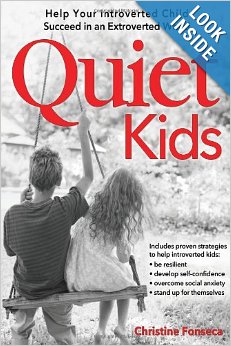Addressing the unique traits in introverted kids. Beautiful video says it all…
Guest Post by Christine Fonseca, author of Quiet Kids: Helping Your Introverted Child Succeed in an Extroverted World
A young boy starts third grade filled with excitement. He walks into the class, not knowing anyone. Somewhat intimidated, he pulls away from the other kids, watching as the other students answer the teacher’s questions. He seldom participates and is considered by the teacher as having a quiet temperament, too quiet. After a few weeks, the teacher grows concerned that the young boy may have learning difficulties. She calls a meeting with the parent, only to discover that the child has never struggled in school previously. The teacher quizzes the student on the current material and discovers that the young boy does know the material-all of the material. Perplexed, the teacher and parent begin to worry that something is “wrong” with the little boy.
Miles away, in a different state, a teenage girl sits with her friends at a local coffee house. She has received the wrong order. But, instead of letting the barista know, she just gives her drink to someone else and pushes aside her frustration with not being able to ask the barista for her correct order. I’m so stupid. I hate being so shy, she says to herself as an overwhelming shame creeps into her thoughts. A few tables away, a group of middle school kids laugh and joke around with each other. That is, all except for one 13-year-old boy. He appears to be distracted, starring off into space. His friends try to engage him in conversation, but he is too lost in his thoughts to notice. After several minutes, one of his friends snaps his fingers in front of the boy’s face, determined to draw his attention. The boy snaps, yelling at the others before leaving the coffee house, frustrated.
Each of these scenarios has something in common. They each feature an introverted child struggling to understand that aspect of his or her nature. And in most cases, the other people involved will misunderstand The terms introversion and extroversion are not new. Most people realize that these terms refer to temperament. However, every time I ask audiences to give me a definition for these words, I get the following list of attributes:
Introverted:
v Shy
v Lonely
v Withdrawn
v Depressed
v Self-centered
Extroverted:
v Outgoing
v Popular
v Likes to be part of a group
v Happy
v Active
These lists paint introversion in a predominantly negative light, while painting extroversion as something worthy of aspiration. It is a belief rep- resentative of our current cultural norms that celebrate extroversion as the ideal, something we must nurture and encourage in our own children. What the list fails to recognize is that temperament, like eye color and physical build, is hardwired. It is neither good nor bad, merely an aspect of who we are. And like most aspects of being, temperament brings with it its own strengths and potential problems. As I mentioned earlier, we live in a world “built” for the extrovert. Our educational system favors group work and collaboration. Our busi- ness culture is heavily focused on collaborative innovation. And our pop culture favors those entertainers who court public attention.
What does this mean for the introverts? Are they supposed to simply alter their DNA in order to fit into the cultural norms? Suppress their need for quiet in favor of social prowess and an outgoing disposition? Is it even possible for them to do this? I have a different idea. Designed to provide support to parents of introverted children, my book, Quiet Kids pulls from current research and redefines introversion as something positive. It sheds light on the strengths of a quiet temperament, as well as providing parents and educators with spe- cific strategies designed to help children embrace their introversion and develop their full potential.
Quiet Kids addresses:
v society’s assumptions about introversion and extroversion;
v the science behind temperament;
v working with introversion at school, at home, and with friends;
v specific strategies addressing resiliency, school performance, and living in a competitive culture; and
v how introversion plays out in the educational setting.
Connect with Christine and continue the conversation at christinefonseca.com, or follow her @christinef. Purchase book here!
ABOUT Christine Fonseca
Critically acclaimed nonfiction and YA author Christine Fonseca is dedicated to helping children of all ages find their voice in the world. By day Christine is a behavioral health specialist in Temecula School District and a speaker and workshop presenter on behavioral health in students and children.
By night, Christine writes nonfiction titles, which delve into the often misunderstood world of emotional intensity, resiliency, and giftedness.
Her non-fiction titles include Emotional Intensity in Gifted Students, 101 Success Secrets for Gifted Kids, The Girl Guide, and the soon to be released Quiet Kids. She is also the author of several young adult novels. Christine writes with a how-to approach, giving parents and educators practical steps for helping children face their world head on.
Christine lives in San Diego with her husband two tween girls, and is a teacher, speaker, life coach and introvert. Join Christine on her blog, where she discusses issues our children face every day at home, in school and at play. christinefonseca.blogspot.com
